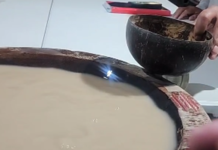Tongan authorities claim the new foreshore structures launched in the Hahake area could provide a new approach for addressing the problem of coastal erosion caused by climate change.
The two structures are known as sedi-tunnel groynes and detached-breakwaters.
They have been used successfully in Europe and some parts of the United States.
Manu Manuofetoa, the National Co-ordinator of the project said the sedi-tunnel groynes consisted of cement boxes erected off the coast of Makaunga and Talafo’ou.
They were intended to interrupt the flow of sand from Afa, Kolonga, Manuka and Navutoka.
The groynes create beaches and prevent sands from being washed away by longshore drift.
Manuofetoa said the detached-breakwater was a 20 metre concrete coast-parallel structure erected at Manuka coastal area. The concrete structures were laid 10 metres apart from each other. They were designed to break the strong currents from hitting the coast.
Manuofetoa said the breakers collected sand and debris drifting along the sea coast, but they also hindered the strong current from eroding the beach.
The EU-funded Global Climate Change Alliance: Pacific Small Island States programme has offered about TP$1.3 million (NZ$890,000) to fund the project.
The project also includes a new children’s playground on Manuka beach.
Manuofetoa said the people of the areas warmly welcomed the project by preparing a feast to welcome the Prime Minister and government officials as well as representatives from the EU, the Secretariat of the Pacific Community GCCA and villagers on the day the programme was launched.
The new structures are part of an €11.4 million (NZ$19 million/TP$27 million) Pacific-wide programme including the Cook Islands, Kiribati, Marshall Islands, Micronesia, Nauru, Niue, Palau, Tonga, Tuvalu.
Coastal zone management is one of a range of projects. Other areas dealt with under the programme include agriculture, health, infrastructure, overall development and poverty reduction, water and sanitation.
The main points
- Tongan authorities claim the new foreshore structures launched in the Hahake area could show the way in addressing the problems of coastal erosion caused by climate change.
- The two structures are known as sedi-tunnel groynes and detached-breakwaters.
- Manu Manuofetoa, the National Co-ordinator of the project said the structures were intended to interrupt the flow of sand from Afa, Kolonga, Manuka and Navutoka.
- The groynes create beaches and prevent sands from being washed away by longshore drift.
For more informationn
Buying Time Tonga – GCCA (Pacific Secretariat)
The fight to save Tongatapu’s coastline (Secretariat of the Pacific Regional Environment Programme)







